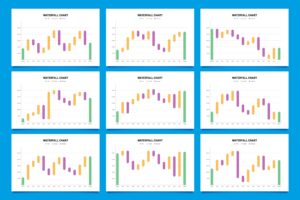Breakout trading is one of the most powerful techniques in the world of stock market investing. It involves taking advantage of significant price movements when a stock surpasses its established support or resistance levels. These levels represent key price points, and when the stock breaks through them, it signals that a major trend is likely to develop. Traders who identify them early can take advantage of these price movements and potentially maximize their gains.
Table of Contents
What is a Breakout?
It happens when a stock’s price rises above resistance or drops below support, crossing a key price level. This is usually accompanied by a sharp increase in trading volume. Volume is a key factor because it indicates sufficient market involvement to maintain the price movement. Without high volume, it may be a false alarm.
Types of Breakouts
Resistance Breakout
When the price moves above a resistance level, it often signals an upward trend. Resistance levels serve as barriers that prevent the price from going higher. When a stock’s price breaks through a resistance level, it indicates that buyers have gained control and are willing to pay more for the stock. A breakout in this case suggests that the stock is entering a bullish phase. Traders will often watch for retests of the resistance level, which might now act as support. If the price stays above the previous resistance level, the trend is confirmed as upward, and traders may decide to go long to benefit from the price movement.
Resistance ones are often seen during earnings reports, new product launches, or other significant events that boost investor sentiment. It’s essential to look for confirmation with volume to ensure that it is not a false move.
Support Breakdown
A breakdown occurs when the price dips below a support level, signaling a potential downward trend. Support levels are price points where stocks tend to find buying interest, preventing the price from falling further. When the price falls below a support level, it suggests that selling pressure outweighs buying interest. This often results in a bearish trend, and traders look for opportunities to enter short positions. A breakdown below support can lead to a significant price decline as the market may view the stock as overvalued.
Traders should be cautious of false breakdowns, also known as “fake outs,” where the price dips below support momentarily but then rebounds. To avoid such pitfalls, traders usually wait for confirmation, such as a close below the support level or increased volume, which indicates that the breakdown is genuine.
Also Read: The ETFs Treasure
Why Breakouts Matter?
They are important because they signal a shift in market sentiment. When a stock breaks through a key level, it usually means that the market has reevaluated the stock’s value, often based on new information or external events. Traders can use this to their advantage by entering the market early, before the larger trend fully develops.
Also Read: Fundamental Analysis
How to Identify Breakouts
Technical Indicators for Breakout Trading
The key to identifying these lies in technical analysis. Traders rely on various technical indicators to detect likely breakout signals. Common technical tools include:
Moving Averages: Moving averages help traders understand the overall trend of a stock. It often occurs when the price crosses a significant moving average.
The Relative Strength Index (RSI) gauges the speed and intensity of price movements. When RSI exceeds 70, it could indicate that the stock is overbought and may experience it.
Bollinger Bands: Bollinger Bands expand when the stock’s volatility increases, making it easier to identify them as the price moves outside the bands.
Also Read: Sector Rotation
Chart Patterns to Watch for Breakouts
Triangle Patterns
Triangles form when price movements become tighter, creating converging trendlines. It happens when the price moves beyond the triangle’s boundaries, either upward or downward, depending on the prior trend.
Head and Shoulders
A head and shoulders pattern signals a reversal in the trend. A breakout through the neckline suggests that the prevailing trend is about to change.
Flags and Pennants
Flags and pennants are continuation patterns that form during strong trends. They form after a sharp price movement and signal that the price is likely to continue in the same direction after it.
Also Read: Double Bottom
Breakout Trading Strategies
Once you’ve identified a potential breakout opportunity, it’s time to develop a trading strategy. Proper entry and exit strategies can help maximize profits while minimizing risk.
Entry Points for Breakout Trades
The best time to enter a trade is after it has been confirmed. Typically, traders wait for the price to settle above resistance or below support to confirm it. They also look for increased trading volume as a confirmation that it is genuine.
Stop-Loss Strategies
Also Read: Nifty Expiry
How to Manage Risk in Breakout Trading
It can be highly rewarding, but it comes with risks. Price movements can be unpredictable, and not every breakout leads to a sustained trend. Here are a few strategies to manage risk:
Using Risk-to-Reward Ratios
A general rule of thumb is to aim for a risk-to-reward ratio of at least 1:2. This means that for every dollar risked, the goal is to earn two dollars in return. This ensures that even if some of these don’t work out, you can still be profitable in the long run.
Diversifying Breakout Trades
Rather than placing all your capital in one trade, consider spreading your risk across multiple positions. This reduces the potential impact of a false breakout on your overall portfolio.
Also Read: Double Top
Common Mistakes to Avoid in Breakout Trading
Entering Too Early
Many traders make the mistake of entering a trade too early, before it is confirmed. Waiting for confirmation, such as a close beyond the key support or resistance level, helps avoid false ones.
Ignoring Volume
Volume is a key indicator in it. A breakout without accompanying high volume is often a false signal. Always use volume as confirmation to improve the likelihood of a successful one.
Why Breakout Trading Works
The power of this trading lies in its simplicity and effectiveness. When you trade these, you’re aligning with the market’s natural tendency to trend. Once it happens, the price often continues in the same direction, offering substantial profit potential.
Also Read: Trading Victory
FAQ: Breakout Trading
What is a breakout in trading?
It occurs when a stock’s price moves past an important support or resistance point, suggesting a possible trend shift or continuation.
How do I confirm if the breakout is valid?
It is confirmed when the price closes beyond a key level with high volume. Always check for confirmation before entering a trade.
Should I always trade breakouts?
Not every breakout results in a successful trade. It’s important to use technical indicators and confirm them with volume to increase success rates.
Conclusion
It offers traders the opportunity to profit from significant market movements. By using technical indicators, recognizing chart patterns, and applying sound risk management strategies, traders can harness the power of breakouts. However, it’s essential to stay disciplined and avoid common mistakes to increase the likelihood of success.
Also Read: Gift Nifty







